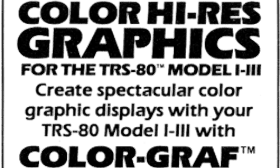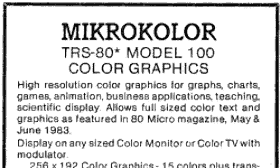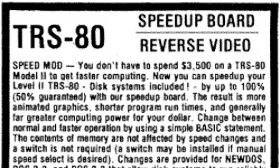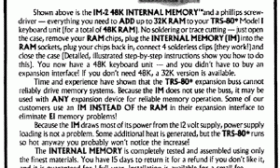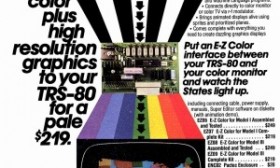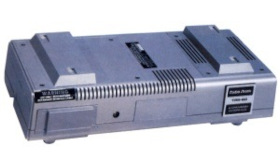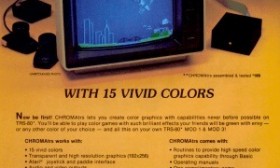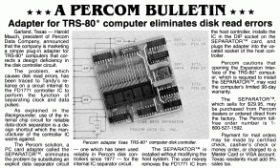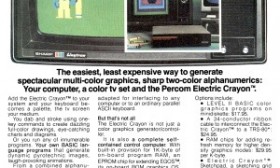Articles in the "Hardware" Category
The Mikrokolor Color Graphics Interface
The Mikrokolor was a color graphics interface for the TRS-80 Model 100 that was sold by Andreasen’s Electronics Research & Development, Inc. The Mikrokolor hardware was designed by Paul Andreasen, the digital interface and graphics routines created by James Cole, and the software written by Andrew Baird. Andreasen’s Electronics Research & Development also sold versions of the Mikrokolor for the Model I, Model III, Model 4, and Model 12 and also the S-100 bus and the Apple II. There was also a $54.00 VHF modulator for the Mikrokolor that operated on channels 7 to 10.
The Mikrokolor fit into much the same category as the later Disk/Video Interface sold by Radio Shack, allowing a Model 100 to be used with a separate monitor. Unlike the Disk/Video Interface, which was black and white only, the Mikrokolor displayed in color.
The Archbold Speedup Board
The TRS-80 Model I ran at a speed of 1.77 MHz. That speed was quite fast for a microcomputer at the time, but almost immediately people began designing speedup boards to increase it. The most famous of those speedup boards was the Archbold Speedup Board, designed by Bill Archbold and sold by Archbold Electronics.
The Archbold Speedup Board itself was a fairly small board (1.5" by 2.5"). It came with an instruction manual containing complete installation directions, including a photo of the Model I logic board. The exact installation procedure varied depending on the hardware installed but involved soldering wires to various points within the Model I and cutting a few traces.
The Holmes Internal Memory
Although the TRS-80 Model I supported up to 48K of memory, there were only sockets for 16K within the Model I itself. The only official way to add more memory was to buy the Radio Shack Expansion Interface, which had sockets for an additional 32K of memory, for 48K in total. The Expansion Interface (without any memory) cost $299.00, making any kind of official memory expansion very expensive.
The other important feature of the Expansion Interface was the built-in floppy disk controller. But not everyone was interested in or could afford floppy drives, which cost hundreds of dollars per drive. Many people used cassettes or other alternative storage devices, such as the Exatron Stringy Floppy, the TC-8, or the BETA-80. What option was there for the Model I user who wanted to maximize memory but without the extras (and expense) of the Expansion Interface?
One answer was the Internal Memory, introduced by Holmes Engineering in 1981. Designed by Larry Holmes, the Internal Memory added memory entirely inside the Model I without requiring an Expansion Interface. It could be easily installed by the user without any soldering or trace cutting. The Internal Memory came in three versions:
The Radio Shack "expansion box"
The TRS-80 Model I was designed to allow for external expansion through what Steve Leininger described as an “expansion port” (the TRS-80 card edge connector). Many people assumed that Radio Shack was developing a S-100 based expansion box to attach to the Model I. (The S-100 was a popular bus standard at the time.)
The first issue of the Radio Shack Microcomputer Newsletter in late 1977 contained a section answering some common questions about the new TRS-80 computer. One answer gave some details about the upcoming “expansion box”:
The Micromint E-Z Color
Micromint sold several products for the TRS-80 that were based on designs that Steve Ciarcia had presented in his Ciarcia’s Circuit Cellar column in Byte magazine. The Micromint E-Z Color was a color graphics interface for the TRS-80 Model I and Model III that was based on his August 1982 column. In addition to the TRS-80 version, there were also versions of the E-Z Color sold for the S-100 bus and the Apple II.
The TRS-80 version was available in two configurations:
The Radio Shack Expansion Interface
The Radio Shack TRS-80 Model I had few options for internal expansion other than adding a maximum of 16K of internal memory. The external expansion possibilities were reserved for a device Radio Shack called the Expansion Interface.
The Radio Shack Expansion Interface plugged into the back of the Model I using a six-inch long cable and was designed to serve as a base for the TRS-80 monitor. It provided:
The CHROMAtrs
Probably the most popular of the TRS-80 Model I and III color add-ons was the CHROMAtrs, introduced by South Shore Computer Concepts starting in 1982. It was available in several configurations:
- a kit without case or power supply cost $99.00
- a kit with case and power supply cost $129.00
- a fully-assembled and tested unit cost $169.00
Each CHROMAtrs unit supported both the Model I or Model III and would work with either computer using the proper cable. The Model III cable would also work with the Lobo MAX-80 with a few minor modifications.
The Percom Separator
The Radio Shack Expansion Interface added single-density floppy disk support to the TRS-80 Model I. Floppy disks were a great improvement over cassettes. But many people reported problems with reliability, particularly when reading or writing lower disk tracks. CRC errors and locked out tracks occurred with disturbing regularity.
The Separator, sold by Percom for $29.95, fixed all of those problems. It provided a data separator with far higher resolution (16 MHz) than the separator used by the Expansion Interface (1 MHz). Good data separation was vital for isolating the clock and data pulses that made up a disk track.
The Electric Crayon
Back in the late 1970’s, the Apple II and the TRS-80 Model I were fierce competitors for computer sales. One advantage the Apple II had over the Model I was the ability to display color graphics. One of the first Model I productsto address this deficiency was the Percom Electric Crayon. Percom introduced the Electric Crayon in December 1979 for a base price of $249.00. It was featured on the cover of the January 1981 issue of 80 Microcomputing.
The Electric Crayon was a small (12 inch wide by 9 inch deep) box which output a composite video signal that could drive either a monitor or a television set. It connected directly to the TRS-80 printer port and was controlled using EGOS, a ROM-based operating system. EGOS was directly programmed using single character commands. Virtually unique among TRS-80 color add-ons, the Electric Crayon did not use the TMS9918 graphics chip and did not support sprites.
